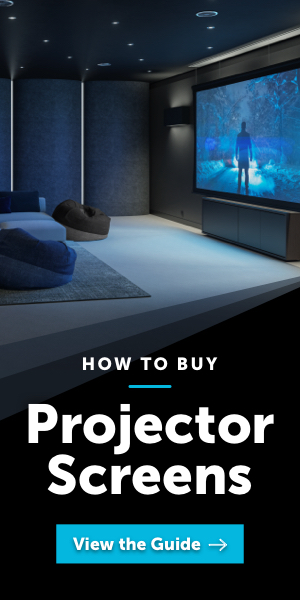At the heart of every projector are two essentials: the imaging technology and the light source. The two interact in such a way that to fully understand your choices for the light source, you also have to know a little about the imaging technology it's paired with, and how imaging technologies work in general. So before we look at today's most common projection light sources—lamp, laser, and LED—and which might be best for your needs, let's start by talking about imaging.
All color displays, including projectors, are built around a core observation of how the human visual system perceives color. Namely, if you're working with light, you need only three primary colors—red, green, and blue—to produce every color the human eye can see. You only have to mix these three primary colors in the right proportions. Or at least that's the essence of it.
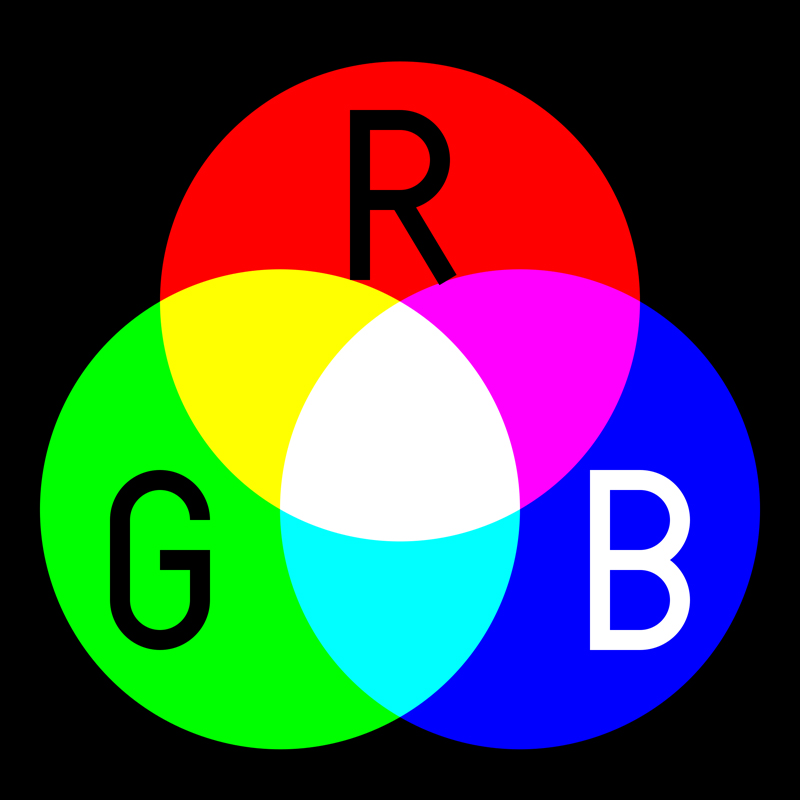
To be precise, the gamut of colors you can produce depends on the choice of red, green, and blue you start with, and if the starting points won't let you create every possible color, you can expand the gamut by adding more colors, like yellow, cyan, and magenta. We'll stay with the simplified version using just red, green, and blue for now, because that's what most displays do. But keep in mind that some add other colors, which we'll get to a little later.
Creating Color
If you launch a Windows or Mac program with a white background and use an 8x jeweler's loupe to look at your desktop or laptop screen up close, you won't see white. You'll see a repeating series of red, green, and blue rectangles—call them dots. Each set of red, green, and blue dots is a single pixel in the image. When you're too far away from the screen for your eye to resolve the individual dots, it integrates the three colors into the color you see, in this case white. Change the intensity of one or more of the primary colors and you'll see the combination as some other color. Turn off the blue dot, for example, and your eye will see the red and green combination as yellow. You might think of this as tricking your eye into seeing a color that isn't there. However, this is just a variation on how we see different colors in real world objects.
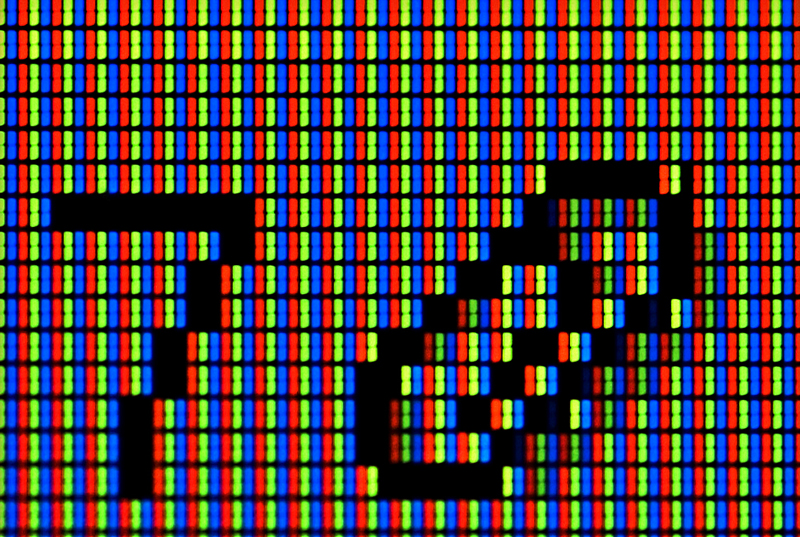
This approach—of putting small dots of three primary colors on the screen at once and letting your eye integrate the colors over space—is also how projectors with three imaging chips work, a group that includes most models that use LCD or LCoS imaging chips, and a few seriously expensive models that use DLP chips. (At this writing, the least expensive, currently produced three-chip model in our database is $27,526.) There are also palmtop and pocket laser projectors that produce colors this way, aiming red, green, and blue laser beams directly at the screen to paint the image dot by dot, one dot at a time.
Time vs. Space
Another way to create color from three primaries is to show the red, green, and blue elements of the entire image separately, in sequence. If you rotate through the sequence repeatedly and quickly enough, your eye will integrate the colors over time. This is how single-chip projectors work, including the overwhelming majority of DLP models.
The potential problem with sequential color is that if the projector rotates through the color sequence too slowly in, say, a scene where James Bond walks across the room quickly while wearing a tuxedo and white shirt, the red, green, and blue elements of the shirt can fall on different parts of the retina. What you see then instead of white is a burst of red, green, and blue, otherwise known as a rainbow artifact. Some people see these more easily than others, and some projectors tend to show them more easily. Which brings us to light sources.
The rule of thumb for rainbow artifacts in single-chip projectors is that a larger percentage of laser projectors do a better job of avoiding them than projectors with LEDs, and a larger percentage with LEDs do a better job of avoiding them than projectors with lamps. This doesn't mean that all laser projectors necessarily show fewer rainbow artifacts than all lamp projectors, but it does mean that if you see these artifacts easily and consider them bothersome, it will be easier to find a single-chip laser projector you're comfortable watching than a single-chip lamp-based projector. That said, most major manufacturers of single-chip projectors have made gains in recent years in minimizing the potential for rainbows, though our usual caveat always applies: if you're sensitive to seeing these or worry you might be, it's best to purchase from a retailer who accepts returns or exchanges.
Putting aside the rainbow factor, there are also some advantages for projectors built around a single chip and sequential color. They're almost always smaller and lighter than equivalent projectors that use three chips, for example. That's one reason why most palmtop and pocket-size projectors use a single imaging chip even for LCD and LCoS models.
White Brightness and Color Brightness
Single chip projectors also tend to be less expensive than equivalent three-chip projectors with the same rated brightness. But the issue of brightness is less straightforward than you might assume, because of the difference between white brightness and color brightness.
Briefly, white brightness—which is what projector lumen ratings refer to unless otherwise specified—measures brightness using a 100% white image. Color brightness measures the brightness for 100% red, 100% green, and 100% blue images separately, then adds the three measurements together.

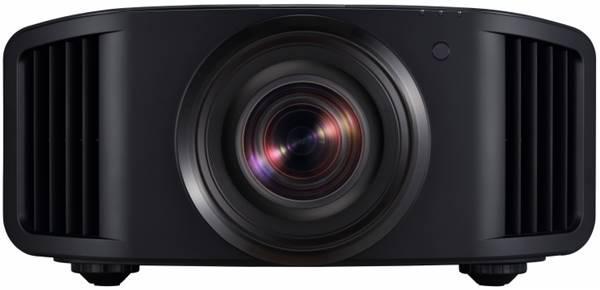
Since three-chip projectors produce white by a combination of red, green, and blue dots, the maximum brightness for white is the same as the total of the maximum for red, green, and blue measured separately. This isn't always true for single-chip projectors, which sometimes add white or other colors to boost white brightness—a subject we'll come back to in a moment. The point here is that a less expensive single-chip projector that offers the same white brightness as a more expensive three-chip projector may have a lower color brightness.
This difference can give a single-chip design the advantage for business or education use, since it can match the brightness of a more expensive three-chip projector for images with a white background—like spreadsheets and word processing documents. But if the single-chip projector also has a lower color brightness—and we've measured color brightness as low as 20% of white brightness in some cases—it won't match the three-chip projector in brightness for full color images like photographs and movies. (You can read more about the difference between white brightness and color brightness in this article.)

All of which brings us back to how projectors create the colors you see on screen along with a quick look at light paths—a light path being the route light follows from source to lens in any given projector.
Light Paths
Light paths describe how a projector creates the red, green, blue (and potentially other colors) it needs; how it shines them through or bounces them off its imaging chips; and how it directs the light at the screen.
There are lots of variations in each step. For example, lamp-based projectors start with the white lamp light, and use filters to separate out the red, green, and blue components. Some LED projectors use red, green, and blue LEDs. Others start with blue and yellow LEDs, and use filters to separate out the red and green. Most laser projectors start with blue laser light, add yellow by aiming the laser at a phosphor that emits yellow when excited, and then use filters to break up the yellow into red and green components.
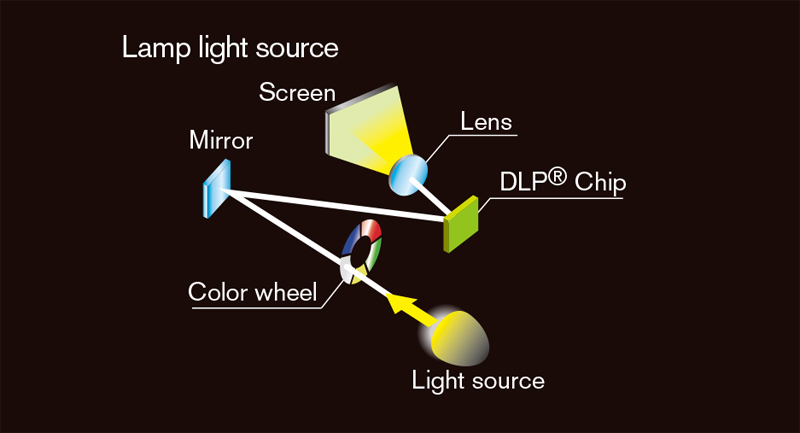
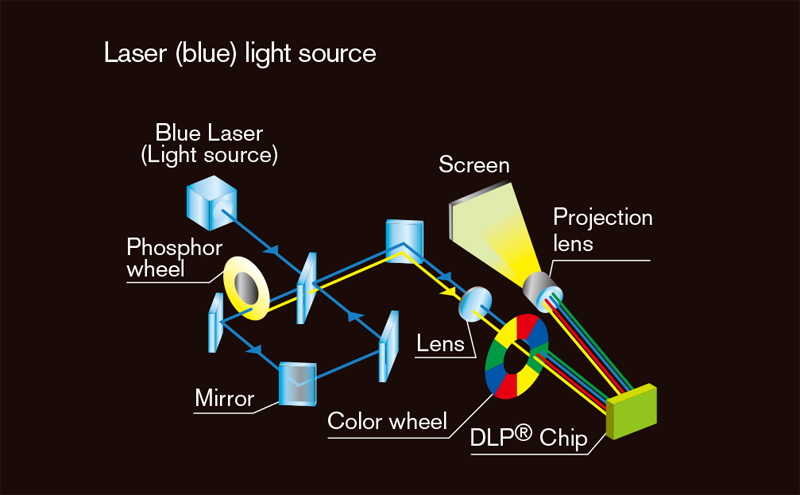
Most of the variations in light paths won't affect your choice of light source. However, one key variation based on the number of imaging chips can.
For projectors with three chips, once you have red, green, and blue, the path is simple: you aim the right color beam at the right chip, and direct all three colors through the lens simultaneously. For single-chip projectors, the path is trickier, since the projector has to send each color to the chip at the right time, namely: when it's ready to project dots in that color.
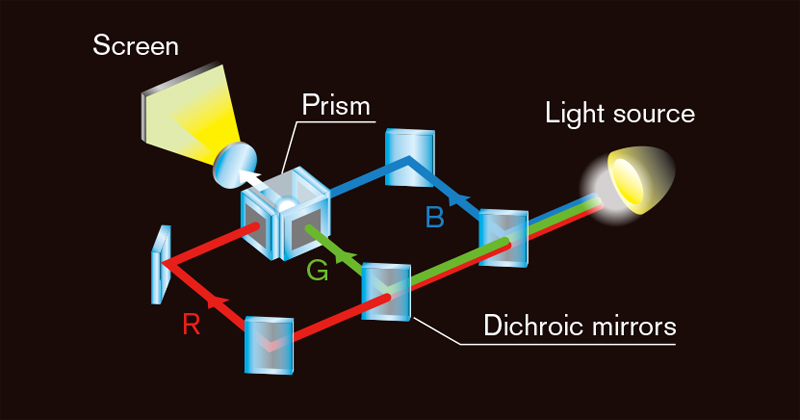
Single-chip LED projectors with red, green, and blue LEDs can simply turn each color LED on and off in sequence. Lamp-based models use a rotating color wheel that holds the color filters and is timed so each color filter is in the path of the light just when the chip needs that color. Most single-chip laser projectors do something similar, using a clear panel on both the phosphor wheel and color wheel to let blue laser light reach the chip and filters on the color wheel to convert the yellow light from the phosphor into red and green.
The color wheels that single chip projectors use makes it easy to add more colors besides red, green, and blue. The most common for lamp based projectors is a clear panel to add white—which is what lets them deliver higher white brightness than color brightness. Others add some combination of yellow, cyan, and magenta. For laser projectors, the most common addition is the yellow produced by the phosphor, simply by adding a clear panel to the color wheel.
The additional colors (and yes, white is a color in this context) can affect the colors you see. Adding white will make the image brighter, but it will also tend to hurt color accuracy, with color errors becoming more and more likely to be noticeable with bigger differences between white and color brightness. On the other hand, adding a yellow panel to a single-chip projector increases the odds that it can show a bright, vibrant yellow that matches the yellows in the best three-chip projectors. And adding yellow, cyan, and magenta panels increases the odds of delivering good color accuracy overall.
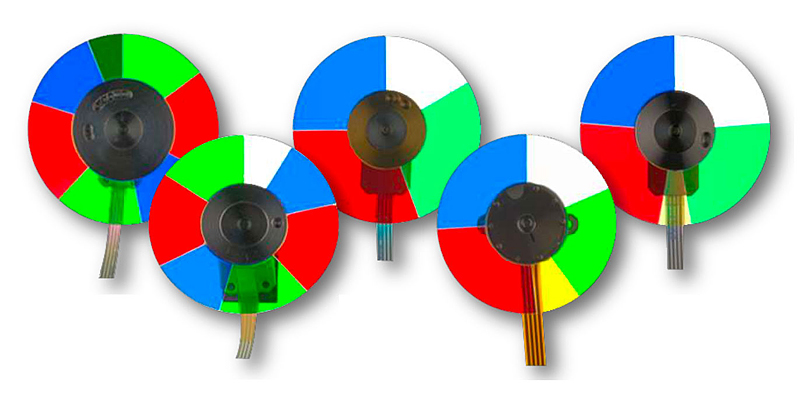
So a lamp-based, single-chip projector with a white panel added to its color wheel is usually desirable if you need a projector to watch in a conference room, classroom, or family room with ambient light. But it's usually a poor choice for a traditional home theater meant for viewing in a dark room. For home theater, color accuracy matters more, and the accuracy will almost certainly be better with just red, green, and blue panels in the wheel. Add some combination of yellow, cyan, and magenta and it may be better still.
And with all this as background, let's finally take a look at the light sources themselves.
Lamps vs. Not Lamps
There are only a few key specs that define the practical difference between lamps and solid-state light sources, meaning both LEDs and lasers: the range of brightness, the typical rated lifetime, and the percentage of initial brightness each loses early on. Lamps are outclassed by both solid-state technologies on two of these factors, and by lasers on all three. In addition, lamps have the shortcoming of containing mercury, which means you have to be concerned about disposing of them properly. All of which suggests lamps may be approaching the dead-man-walking phase of their evolution. But they're not there yet.
The brightness range for current lamp-based projectors in our ProjectorCentral Find a Projector database is roughly 1,000 to 43,000 lumens, although you can still find some rated at a few hundred lumens. The top brightness is a lot higher than for LED projectors, which range from 10 lumens to 4,500 lumens, but lower than for laser projectors, at 32 lumens to 75,000 lumens.
Lamp life varies with the projector model. For current projectors, it ranges from 2,000 to 10,000 hours in full power mode, and from 2,500 to 20,000 hours in Eco mode. But Eco mode ratings of 15,000 hours or more generally get their long life from features like slowly lowering power use—and brightness—when you leave the projector on for a while without the image changing. This can be useful in, say, a classroom where you might leave the projector running for some time even when you're not using it. But if you rarely or never do that, the lamp won't last that long.
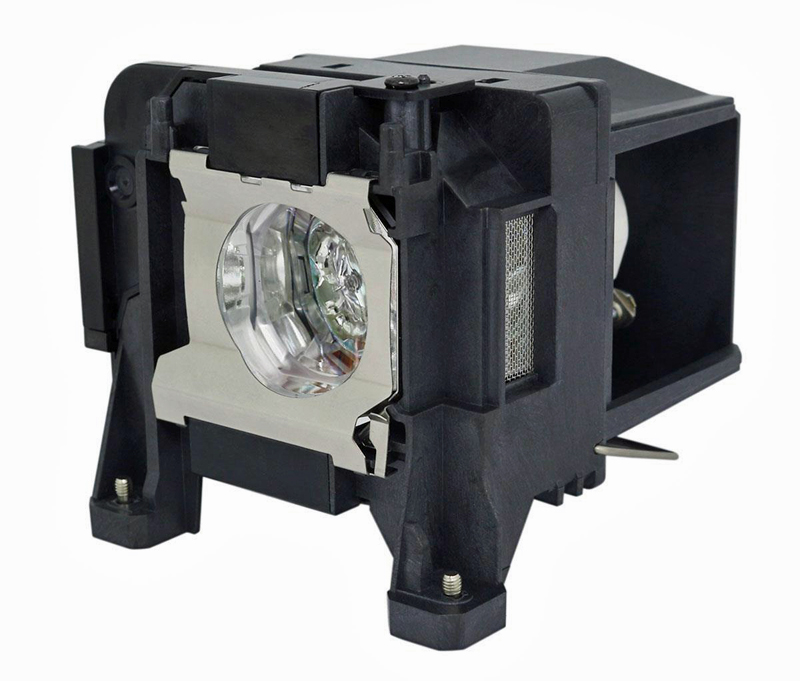
In contrast, the vast majority of lasers and LEDs are rated at 20,000 hours or more at full power, and typically 30,000 hours in Eco mode. Some claim even longer lives. Note that end of life for LEDs and lasers isn't defined the same way as end of life for lamps, but both ratings are rough predictions of the light source's useful life.
Lamps also lose brightness more quickly than solid-state light sources, often by as much as 25% in the first 500 hours of use, then dropping more gradually to the 50% that defines end of life after that. Solid state projectors take longer to drop to any given percentage of initial brightness only partly thanks to their longer lives. They also have somewhat closer to a straight line of steady loss of brightness over their entire lives, rather than dropping halfway to end of life levels early on.
Initial Cost and Total Cost
One clear strong point for lamps is low cost, which lets you buy a lamp-based projector for significantly less than the equivalent solid-state projector. But although a low initial price is obviously attractive, the key phrase is initial price. You should also consider the total cost of ownership.
Basically, the more often you expect to use the projector and the longer you expect to have it before replacing it, the more lamps you'll have to buy. What this translates to is that if you're planning to use a projector strictly for watching one or two movies a week, and you're the sort of videophile who wants to upgrade with every new innovation that comes to market—higher resolution, 3D, HDR, better implementation of HDR, and so on—the initial price may be your total cost. The same logic applies for a business, church, or school that expects to use the projector only a couple of hours a week.
At the other extreme, if you're buying a projector to use in a classroom or at home as a TV for five or more hours per day, and you don't expect to replace it before it becomes hopelessly obsolete, the cost of replacement lamps may be significant. In that case, you might want to calculate how many lamps you'll likely buy over the projector's lifetime and add the cost to the initial price. You may find that the lamp based projector winds up costing more in the long run. If so, a more expensive, solid-state projector can be the better buy—provided, of course, that it delivers the level of image quality you want.
LEDs, Lasers, and Hybrid (Laser-LED) Light Sources
LEDs are the light source for the overwhelming majority of small projectors, from sizes that will fit in a shirt pocket to palmtops and a little larger up to just under 2 pounds. Because the brightness for these projectors can be well below 100 lumens and is no more than 1,500 lumens, they're generally designed to get the most brightness possible from the LEDs, which often results in vibrant, but oversaturated, color. Few people, if any, would consider this a problem for business or classroom use. But if you want to watch movies or show photos, you'll have to make allowances with some of these models for colors that wander outside of a realistic range.
The few small projectors that don't use LEDs draw the image directly with lasers. This gives them an advantage specific to laser light. Just point the projector at any surface at any distance, and the image will be in focus. Unfortunately, another property of laser light is speckling artifacts. The speckles are less obvious in some models than others, but to minimize the speckling they defocus the image a bit. So with these models, you'll have to choose between a projector with the best possible focus or one without speckles.
Somewhat larger and brighter projectors, in the range of about 1,500 to 4,500 lumens, give you a choice in solid-state light sources of LEDs, Lasers, and LED-laser hybrids. All of the current hybrids at this writing are single-chip DLP projectors that are designed to emphasize brightness over good contrast and color accuracy, which means they're most appropriate for business and education. As with lamp-based projectors, any given LED projector can be designed for either kind of application, but even those that are designed for home theater use—and there are some that are specifically intended to replace flat-screen TVs—tend to have color accuracy that's best described as good enough.
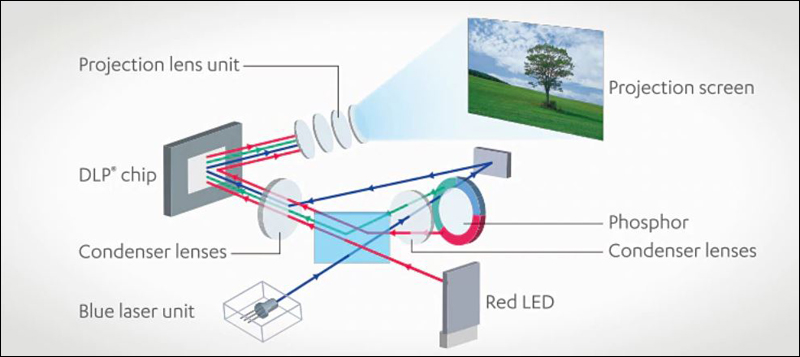
Lasers
Lasers in any brightness range can potentially deliver color accuracy and contrast as good as or better than lamp-based projectors—even though many laser projectors at this writing don't do so. And unlike lamp-based and LED models, even laser projectors designed to emphasize brightness over contrast and color accuracy can almost always handle movies well enough to be highly watchable.
Another advantage for laser projectors is that they tend to be far more useable at their highest brightness levels than lamp-based or LED models. All projectors' brightness ratings are based on settings that sacrifice color accuracy. For LED and lamp-based projectors, this typically adds a noticeable green bias. But most laser projectors deliver good enough color accuracy even in the brightest mode that most people would consider the colors more than acceptable for photorealistic images.
There are also some other advantages to laser light sources. Most laser projectors that pair the laser with a DLP chip, and some that use three LCDs, are virtually maintenance free, suitable for 24/7/365 operation, and can be mounted in any orientation over 360 degrees in all three axes. Having a maintenance-free projector is a welcome convenience for anyone. But the combination of features makes laser projectors the obvious preferred choice for certain kinds of applications, including digital signage, museum exhibits, and displays in locations from houses of worship, to retail stores, to corporate front lobbies and elsewhere.
For all these reasons, or until such time as LED catches up on laser's ability to deliver higher brightness, it seems lasers are bound to take over as the dominant—and eventually, perhaps, only—projector light source. For the moment, however, lasers, LEDs, and lamps each have their place. You just have to choose the right one.
I'm interested in getting H3 or next model when it comes. Your opinion about their performance will be of great help 😄
From what I have seen in my projector it is basically a light source. One of the supplier supplied me with a wrong model and it worked because I was able to bring in the case.
Now the question is also if you could have a light source that would be much stronger? Would it affect the colours since the color wheel would have to be aligned with the light power?
Needless to remember: an LED light source would emit heat and require cooling too (don't underestimate it). But fewer power might to lead less heat (or maybe heat more concentrated).
I will think about to buy an LED Chip with 7500LM and 100W and aprox 2$ (where the bulb would be of 1600lm and 170W and approx 30$) at aliexpress.
Most important part would be to fix it correctly and to cool it, I guess.
Kind regards MrE
Thanks




